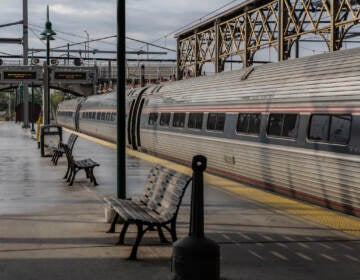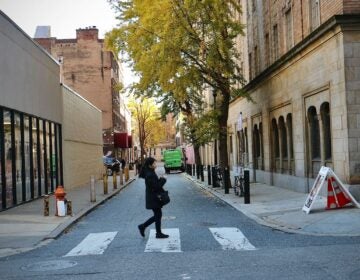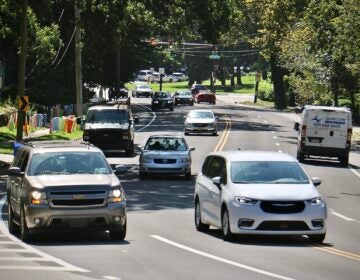Grays Ferry Bridge is scary for cyclists and PennDOT’s rebuild won’t solve the problem
The $13.3 million reconstruction of the Grays Ferry Bridge will include a protected bike lane — but only on one half of the bridge.

A rendering of the final layout of the Grays Ferry Avenue Bridge. (PennDOT)
This article originally appeared on PlanPhilly.
—
The $13.3 million reconstruction of the Grays Ferry Bridge will include a protected bike lane — but only on one half of the bridge, renderings from the Pennsylvania Department of Transportation show.
Aaron Bauman, a software engineer who bikes across the bridge regularly, was surprised to discover that the new safety features are planned only for the eastbound lane. He said the highway-style bridge badly needs protected lanes because drivers habitually speed across the 1,482-foot span.
“The Grays Ferry Bridge is so wide and carries so little traffic that it induces drivers to go 50 miles per hour,” he said. “I rode in the former bike lane exactly one time before I disavowed it completely in favor of the sidewalk.”
Cyclists like Bauman aren’t alone. A 2012 city report on conditions found that its unprotected bike lane put cyclists dangerously close to the 30,000 speeding cars that cross the bridge each day. The same report found that the lack of a barrier also turned the bike lane into a dumping ground for trash and other debris.
The Grays Ferry Bridge traces a river crossing that has served as a gateway between South and Southwest Philadelphia for centuries. The city replaced a historic bridge with its current two-track highway-style crossing in 1976. Today it serves as a “primary commuter route to and from the city’s major employment centers in University City,” according to PennDot.
The state transportation agency began rehab in January aimed at repairing the bridge’s deteriorated structure, replacing its drainage system and making several “people-friendly improvements.”
Among these improvements is a jersey barrier that will separate a mixed-use bike and pedestrian path on the eastbound track. Yet the planned bike lane on the westbound side will remain unprotected.
So, why are eastbound travelers protected and not those riding west? PennDOT spokesperson Brad Rudolph described an ad-hoc design process for the project.
He said his agency first intended to rebuild the bridge without any protected bike lanes at all. That changed when city officials approached the agency during the project’s design phase. The city requested a better connection between the rebuilt bridge and Grays Ferry Crescent, a waterfront park near the bridge’s eastern landing.
“The request was made by the city to have a bidirectional bike/pedestrian lane to link the existing trailhead path on the south side of the bridge that leads to Grays Ferry Crescent,” Rudolph wrote in an email. “Because it is bidirectional, and bicyclists and pedestrians are walking against traffic, a barrier must be installed for safety and protection.”
Rudolph said the city requested a protected bicycle lane with a physical barrier westbound lane two years ago. It is unclear why PennDOT did not accommodate the desire for protection on both sides of the bridge.
A new bike-and-ped-only bridge, known as Schuylkill Crossing, will eventually allow riders to cross to Bartram’s Garden in the shadow of the Grays Ferry bridge, free from car traffic. But Erick Guerra, an assistant professor at the University of Pennsylvania School of Design who studies regional car accident data, said the existing bridge could nonetheless be made safer for those who continue to use the familiar crossing.
He said that even if it’s too late for buffers, plastic bollards to separate cyclists from drivers could easily improve safety on the rebuilt bridge’s unprotected lane.
“Obviously, the Grays Ferry Bridge is not a place you want to interact with cars while you’re on a bike, because they’re going pretty fast,” he said. “There’s no reason not to put bollards up here. They don’t provide protection, but at least they provide separation.”
But he also critiqued the protected lane that PennDOT did add at the city’s request, which he described as a recipe for collisions between bicyclists and pedestrians, particularly at night.
“As a cyclist and cycling advocate, I might rather ride in the unprotected lane because the protected lane is mixed with pedestrians,” Guerra said.
The planner said PennDOT missed an opportunity to address the bigger issue of excessive auto speeds on the bridge and its landings. Although there were no recent fatalities reported near the bridge, PennDOT crash data shows that the bridge was the site of about 90 accidents between 2011 and 2017. Most were clustered at the intersections and pedestrian crossings at the end of either bridge landing.
Rudolph from PennDOT said that the agency “would certainly consider changes [to the bridge design] if warranted and at the request of the city or stakeholders.”
Reconstruction is expected to complete in late 2020.
Editors Note: This article was updated on Thursday, August 8, 2019 with a corrected statement from PennDOT. The incorrect information contained in the prior version came from PennDOT.
WHYY is your source for fact-based, in-depth journalism and information. As a nonprofit organization, we rely on financial support from readers like you. Please give today.







